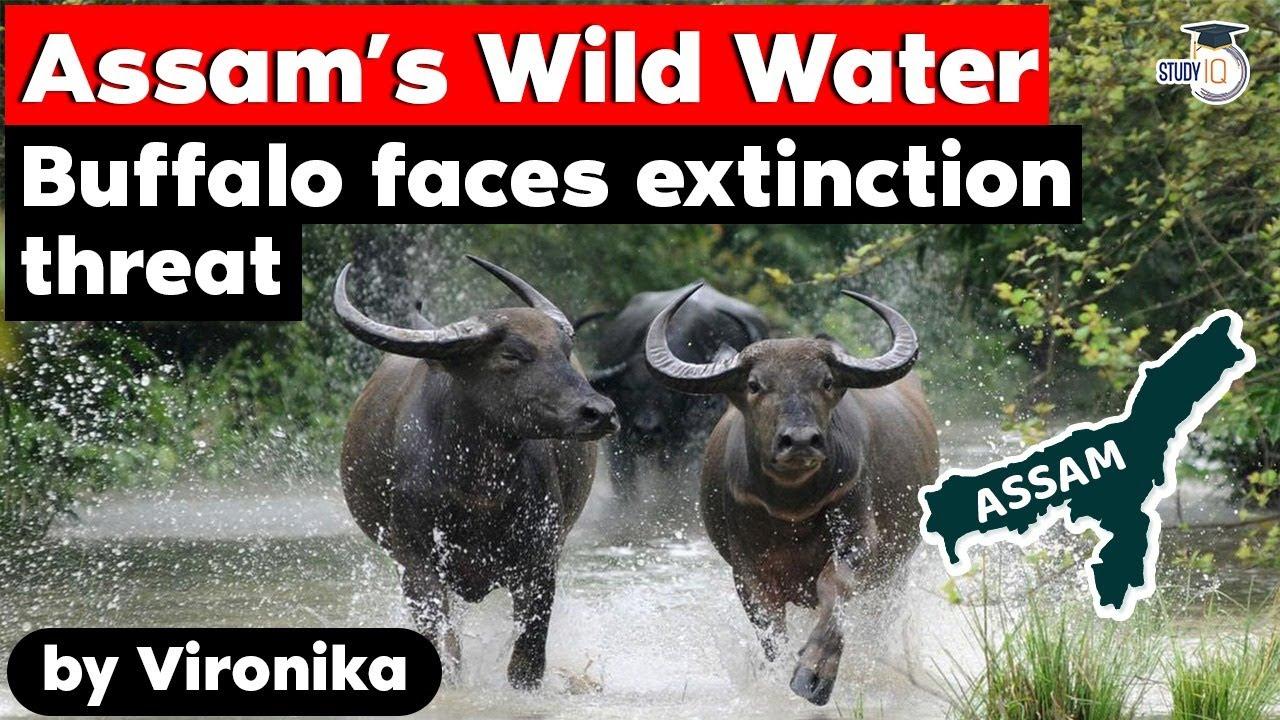Table of Contents

- Assam’s wild water buffalo population, that was once abundant, saw a dramatic decline, primarily because of colonial hunting for over 150 years.
- Listed as ‘endangered’ in the IUCN Red List since 1986, the wild water buffalo population in Assam faces threats such as habitat loss, fragmentation and degradation due to natural and anthropogenic factors.
- A 2010 study estimated the global population of the wild water buffalo at 3,400 individuals, of which 3,100 (91%) live in the forests of Assam and the rest are scattered in the Indian states of Chhattisgarh (where it is the state animal) and Arunachal Pradesh, as well as Nepal, Bhutan, Thailand, and Cambodia.
- In Assam, the species now faces a new suite of threats. While interbreeding with domestic buffaloes is commonly identified as one of the key factors contributing to the decline of wild water buffalo populations across habitats, conservationists and experts say that, in Assam, the loss of habitat is pushing this iconic species into troubled waters.
- The Vanishing Herds: The Wild Water Buffalo says that there is a general belief that interbreeding with domestic buffaloes has affected wild buffalo populations, but this seems to be incorrect as a rule. Domestic males are usually not kept in villages on the fringes of national parks, because they are generally killed by wild bulls.
- In fact, it is some wild bulls, which regularly come out of the parks, that mate with domesticated females. Therefore, the gene flow is mostly one-way, wild to domestic, and is unlikely to affect any substantial wild population
- The wild water buffalo uses wetlands (42.29%) and short grasslands (37.01%) as its primary habitats, followed by the tall grassland habitats (15.83%) with minimal use of woodlands (4.78%),
- According to a 2014 doctoral studyat Gauhati University that looked at the annual habitat selectivity of the wild water buffalo in Kaziranga National Park, the key protected habitat that hosts over 1,400 individuals of the species nearly half of Assam’s wild buffalo population.
Loss of wetlands, marshes, and grasslands
- The Assam Remote Sensing Application Centre has identified 3,513 wetlands in the state, spread over 764,372 hectares – 9.74% of the state’s area.
A Report
- A study published in the journal River Research and Applications in 2020 finds that between 1988 and 2018 the Kaziranga National Park has lost 1114.7 ha waterlogged wetland (31.3%), 425.5 ha marsh/swamp (70.4%) and 394 ha of grassland due to land cover transition caused by siltation, flood, erosion, and spread of exotic and invasive species among other factors.
- The Brahmaputra floodplains landscape is known to be dynamic, and accretion of land naturally counteracts erosion, but the study points out the fact that “it takes several years of vegetation succession to regenerate back to forest” to act as suitable wildlife habitats.
- Erosion poses another serious threat to wild buffalo habitats. Kaziranga National Park has lost an area of 5,342.6 ha to erosion at the rate of 184.2 ha/year during 1987-2016,

- According to a 2019 study by Tezpur University. Similarly, the Dibru-Saikhowa National Park, which is a complex of wetlands, grasslands, littoral swamps and semi-evergreen forests, an ideal habitat of the wild buffalo, lost an area of 77.14 sq. km. to the widening Brahmaputra and the Dibru river between 1990 to 2006, according to this estimate
- In several protected areas across Assam that harbour wild buffalo populations, invasive species are threatening the native vegetation cover through conversion, especially from grassland to scrub forest with potential impacts on various herbivorous species including the one-horned rhinos
Expansion of Agriculture
- In addition to these natural factors, the expansion of agriculture into previously unclaimed riparian tracts is also responsible for the loss of wild buffalo habitats. Outside protected areas, wetlands the wild buffalo’s preferred habitats are often considered as wastelands to be reclaimed to be drained, or farmed upon.


- The Central India Wild Buffalo Recovery Project aims to stabilise the wild buffalo population in Udanti-Sitanadi Tiger Reserve, Chhattisgarh by implementing a number of ex situand in situ
- A joint venture between WTI and the Chhattisgarh Forest Department, the project began with the evaluation of the number of wild buffaloes in four wildlife sanctuaries – Udanti, Pamed, Sitanadi and Bhairamgarh – and a national park – Indravati – in Chhattisgarh.
- Ensuring zero unnatural deaths of the remaining individuals Habitat improvement
- Population augmentation by re-stocking (especially females) from closely-related populations or conservation breeding.
- Habitat restoration activities like de-weeding, fire prevention and ensuring water availability have been conducted to provide a suitable habitat to the wild buffaloes.
- Wild Buffalo (Bubalus arnee)
- The wild buffalo is mainly found in the alluvial grasslands, marshes, swamps and river valleys. They are generally found in areas that have plenty of water holes and resources
IUCN status
- The estimated population of the wild buffaloes in the Northeast is around 3,000-4,000, the largest in the country and accounting for 92% of the world population.
- It is listed under Schedule 1of the Wild Life (Protection) Act, 1972.
- It is classified as endangeredin the IUCN Red List of Threatened Species.
- The wild water buffalo occurs in India, Nepal, Bhutan, Thailand, and Cambodia, with an unconfirmed population in Myanmar.
- It has been extirpated in Bangladesh, Laos, Vietnam, and Sri Lanka. It is associated with wet grasslands, swamps, and densely vegetated river valleys.
Q.Consider the following statements about Wild Buffalo :
- The wild buffalo is mainly found in the alluvial grasslands, marshes, swamps and river valleys.
- It is listed under Schedule 2of the Wild Life (Protection) Act, 1972
Which of the statements given above is/are correct?
(a) Both 1 and 2 are correct
(b) 1 Only
(c) 2 only
(d) Both 1 and 2 are incorrect

























 WhatsApp
WhatsApp